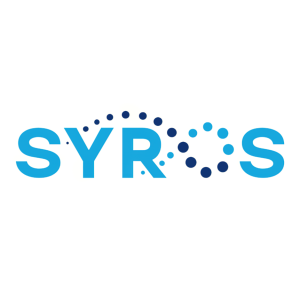Syros Presents New Preclinical Data on its CDK12 Inhibitor Program at American Association for Cancer Research (AACR) Annual Meeting 2022
Syros Pharmaceuticals (SYRS) announced promising preclinical results for its CDK12 inhibitor program, showcasing strong anti-tumor activity in breast, lung, and ovarian cancer models. The data, presented at the AACR Annual Meeting 2022, indicate that the CDK12 inhibitors have low nanomolar potency and selectivity against other CDKs. The inhibitors demonstrated significant tumor regression in animal models and synergy with DNA damaging agents. Syros plans to nominate a development candidate in the second half of 2022, targeting patients resistant to current therapies.
- Strong anti-tumor activity demonstrated in preclinical models.
- CDK12 inhibitors show low nanomolar potency and selectivity.
- Significant tumor regressions observed in lung and breast cancer models.
- Planned nomination of a development candidate in 2H 2022.
- None.
CDK12 Inhibitor Demonstrates Strong Anti-Tumor Activity as Single Agent and in Combination with a DNA Damaging Agent and a PARP Inhibitor in Models of Breast, Lung, and Ovarian Cancer
On Track to Nominate CDK12 Inhibitor as Next Development Candidate in 2H 2022
“CDK12 is an attractive cancer target due to its role in transcription and DNA damage repair regulation. Leveraging our selective CDK inhibition expertise, we discovered potent, selective, and oral CDK12 inhibitors, which affect the expression of genes involved in DNA damage response to drive anti-tumor activity,” said
Preclinical Data from Oral CDK12 Inhibitor Program
Syros designed a series of CDK12 inhibitors that were profiled in biochemical and cellular assays. The data presented at AACR detail for the first time the potency, selectivity, and anti-tumor activity from a representative member of the class, which exhibited low nanomolar potency and selectivity over CDK2, CDK7, and CDK9 of 46-, 27-, and 9-fold, respectively.
As a single agent in cancer cell models, this CDK12 inhibitor induced DNA damage, cell cycle dysregulation and genomic instability leading to growth inhibition and apoptosis. Additionally, as a single agent in in vivo cancer models this CDK12 inhibitor demonstrated tumor regressions in small cell lung cancer and breast cancer models, at well tolerated doses.
In combination in vitro, this CDK12 inhibitor showed synergistic or additive antiproliferative effects in combination with the DNA damaging agent, lurbinectedin, and the PARP inhibitor, olaparib, with increases in DNA damage and impaired DNA damage repair. In vivo, CDK12 inhibition in combination with lurbinectedin showed enhanced anti-tumor activity in a cell line derived model of small cell lung cancer, and in combination with olaparib showed enhanced anti-tumor activity in a PARP inhibitor resistant patient-derived model (PDX) of ovarian cancer.
The poster is now available on the Publications and Abstracts section of the Syros website at www.syros.com.
About
Syros is redefining the power of small molecules to control the expression of genes. Based on its unique ability to elucidate regulatory regions of the genome, Syros aims to develop medicines that provide a profound benefit for patients with diseases that have eluded other genomics-based approaches. Syros is advancing a robust clinical-stage pipeline, including: tamibarotene, a first-in-class oral selective RARα agonist in RARA-positive patients with higher-risk myelodysplastic syndrome and acute myeloid leukemia; SY-2101, a novel oral form of arsenic trioxide in patients with acute promyelocytic leukemia; and SY-5609, a highly selective and potent oral CDK7 inhibitor in patients with select solid tumors and blood cancers. Syros also has multiple preclinical and discovery programs in oncology and monogenic diseases. For more information, visit www.syros.com and follow us on Twitter (@SyrosPharma) and LinkedIn.
Cautionary Note Regarding Forward-Looking Statements
This press release contains forward-looking statements within the meaning of The Private Securities Litigation Reform Act of 1995, including without limitation statements regarding the ability to nominate a development candidate from Syros’ CDK12 inhibitor program and the timing thereof, and the role of CDK12 inhibition in breast, lung, and ovarian cancer treatment. The words ‘‘anticipate,’’ ‘‘believe,’’ ‘‘continue,’’ ‘‘could,’’ ‘‘estimate,’’ ‘‘expect,’’ “hope,” ‘‘intend,’’ ‘‘may,’’ ‘‘plan,’’ ‘‘potential,’’ ‘‘predict,’’ ‘‘project,’’ ‘‘target,’’ ‘‘should,’’ ‘‘would,’’ and similar expressions are intended to identify forward-looking statements, although not all forward-looking statements contain these identifying words. Actual results or events could differ materially from the plans, intentions and expectations disclosed in these forward-looking statements as a result of various important factors, including Syros’ ability to: advance the development of its CDK12 program under the timelines it projects; demonstrate in any current and future clinical trials the requisite safety, efficacy and combinability of its drug candidates; replicate the results seen in preclinical studies in human clinical trials; obtain and maintain patent protection for its drug candidates and the freedom to operate under third party intellectual property; obtain and maintain necessary regulatory approvals; identify, enter into and maintain collaboration agreements with third parties; manage competition; manage expenses; raise the substantial additional capital needed to achieve its business objectives; attract and retain qualified personnel; and successfully execute on its business strategies; risks described under the caption “Risk Factors” in Syros’ Annual Report on Form 10-K for the year ended
View source version on businesswire.com: https://www.businesswire.com/news/home/20220408005014/en/
Media Contact
917-698-9253
csolberg@syros.com
Investor Contact
Stern Investor Relations, Inc.
212-362-1200
hannah.deresiewicz@sternir.com
Source:
FAQ
What are the recent developments in Syros Pharmaceuticals' CDK12 inhibitor program?
What types of cancer are targeted by the CDK12 inhibitor?
When does Syros plan to nominate a development candidate for CDK12?







